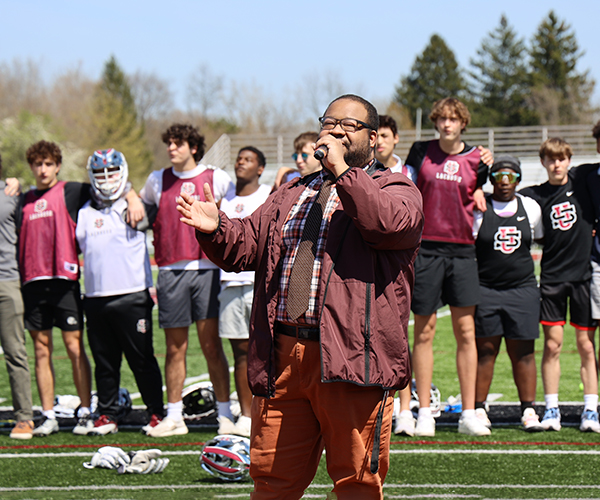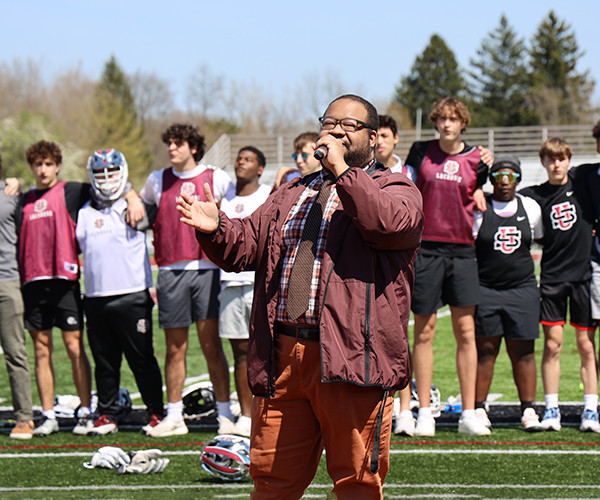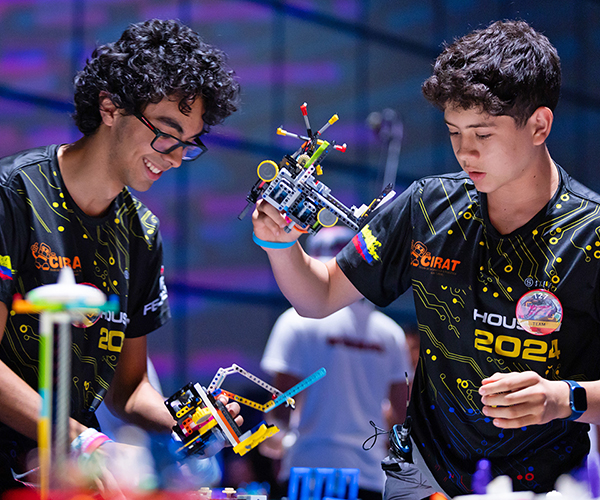In a newly converted classroom, shiny with floor-to-ceiling whiteboard paint and lined with a half dozen new iMacs lies a virtual playground for a kid dreaming of YouTube fame.
Three small rooms, each lined with acoustical tiles, stand ready for video editing and audio recording, mixing and broadcasting. Soundproof doors — also covered in whiteboard paint — give way to a brand new production studio lined with black drapes and a green screen that covers a wall and a half.
It will soon also be occupied by two new wheel-mounted cameras, soundboards, boom microphones and an overhead grid system to hang lighting. Up to six additional handheld cameras will be available to students, and in a large common area, a 105-inch monitor will be wall-mounted to watch recording in process.
This is Hawken School’s new media and communications lab, better known as the M.A.C. Lab, which was just one small part of the $25.5 million school renovation completed this year.
“We as educators are doing school differently now,” says Nick DiGiorgio, Hawken’s director of maker and media spaces, who oversees both the M.A.C. Lab and the school’s new Fab Lab makerspace. “We are leaning toward a model of education where we want the kids to be more hands-on.”
There’s no curriculum structured around the M.A.C. Lab — and that’s by design. How this space is used will depend on the personal and academic interests of Hawken students and faculty.
Previously, DiGiorgio had created makerspace programs over his 15 years with the Cleveland Metropolitan School District, consulted in the creation of makerspaces in high schools throughout the country and presented on the topic at international education conferences. Hawken recruited him in 2015 to create the digital production and fabrication labs, which opened in August.
Teachers are already brainstorming new ways of using the M.A.C. Lab in instruction, DiGiorgio says, but even a student YouTuber or a budding podcaster could use it to dramatically improve the quality of what they create.
“They already know how to mix beats on a DJ app or do their own video with their iPhone,” he says. “If they can take it to a whole other level in this space, then that’s what we have it for.”
A growing number of schools are investing in digital media equipment and tools while exploring new ways of integrating digital media into the learning environment. For many, it’s no longer enough to throw students in front of a camera once a day for closed-circuit announcements on classroom TVs. In a world dependent on digital media, educators face the challenge of making such technology a learning tool, not just an expensive add-on.
“A lot of our old educational tech initiatives had been a victim of very common gimmicks and trends but missing an actionable plan [that can] affect how we teach,” says Dan Adiletta, coordinator of academic technology at Gilmour Academy.
EVERYONE’S GOT A STORY
At Gilmour, students begin in fourth grade using the drag-and-drop WeVideo app to create, edit and enhance videos with music and effects on their mobile devices or computers.
Likewise, high school students can post their projects to a Gilmour-specific site using the online collaboration tool Tackk and share them with each other, their teachers and their families.
Perhaps the most impressive use of such technology at Gilmour is a project called Digital Storytelling. As part of the high school English class, students create a four- to six-minute digital composition using words, images, video, music and sound.
“It dramatically improves the quality of students’ work when they know that their work will be seen outside of the classroom,” says Adiletta.
That’s important even for those hoping to pursue studies outside digital media, filmmaking or communications. Such projects promote collaboration and teach creative problem-solving. “There are critical, practical skills to video production,” says Adiletta. “College and workplace readiness is a significant focus at Gilmour, and video projects help get our students there.”
For DiGiorgio, media production is today’s answer to public speaking and presentations that go beyond PowerPoint. “It’s one more place to enhance communication skills, which can be used in any field,” he says.
SEEING GREEN
You won’t find a green screen in Holy Name High School’s video production studio. They are the Green Wave after all, and students constantly wear the color, making them seem to disappear when standing in front of such a screen.
But they get plenty of use out of their blue screen instead, which lives in the studio along with a teleprompter, two cameras and a TriCaster production tool used for editing and broadcasting live or recorded content.
Home to a media production class, the room has the potential to be used as part of a new content marketing initiative called Afterschool Pulse, which includes a blog, podcasts and videos in collaboration with WTWH Media, a business-to-business media company co-founded by Holy Name alumnus Scott McCafferty.
The result will be a student-run media company supported by WTWH, which hosted a half-dozen Holy Name students for four hours a day this summer to work on Afterschool Pulse. Initially the project will be run as a club, but teacher Peter Knittel has a long-term goal of creating a Content Media class.
“When I consume media, I am far more likely to watch a three-minute video than read a 1,500-word article,” says Knittel, who oversees the school’s broadcast studio and teaches media production, web design and Latin. “Students are already making this content anyway. … When schools see kids with those skill sets, they are in a good position to capitalize on that.”
Last year, Notre Dame-Cathedral Latin School also transformed its traditional library into a space it calls the Learning Commons, which includes a broadcast studio, distance-learning lab and nine smart TVs that are connectable to mobile devices and computers. Students are permitted to use the broadcast studio when they wish, and the school is considering plans to add a makerspace to the Learning Commons.
While there’s no curriculum wrapped around the space, teachers and students are challenged to think of new ways to use the tools, says media specialist Amy Myers. The school has a full-time technology coach on-site who helps teachers incorporate the technology into their lessons.
“It’s not just what you have,” says Myers. “It’s how you use it.”
TO GOOD USE
At Hawken, DiGiorgio is already hearing from faculty about how they’ll be using M.A.C. Lab this year.
One acting teacher is doing a three-week comedy intensive and will likely use the studio for a Saturday Night Live-style comedy news report. Foreign language classes will create reports there. Performing arts will learn the differences between acting onstage and on camera.
DiGiorgio dreams of one day seeing a student-produced documentary about Hawken screened at a festival like South by Southwest.
But while many schools don’t have the resources or space to invest in media production equipment and instruction, DiGiorgio insists that these principles can be applied anywhere.
Many free tools are available online that make use of equipment many schools already own or sync with students’ mobile devices. The most important thing, he says, is a willingness on the part of school administration to try something new.
“You don’t need high-end computers to do this,” he says. “It’s got to start at the top. You have to get permission to do things differently — to do school differently.”




